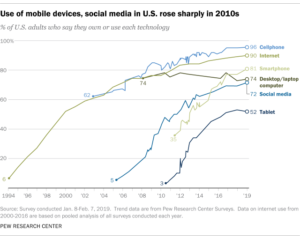
Few would argue there has been major change in the last decade. Pew Research has usefully charted many of the most dramatic changes – from where Americans can get their news to the size of US households.
Fueled by technology advances, a majority of Americans have gone digital. Ninety percent use the internet compared to 74 percent a decade ago and only 6 percent as recently as 1994. More than 50 percent own or use a computer tablet contrasted to just 3 percent in 2010. Presence on social media has ballooned from 5 percent in 2005 and 45 percent in 2010 to 72 percent in 2019.
Increased engagement on social media has had an impact on news consumption, according to Pew. “In 2018, for the first time, social media sites surpassed print newspapers as a news source for Americans. One-in-five adults said they often get news from social media, slightly higher than the share who often did so from print newspapers (16%). Among social media sites, Facebook dominates in terms of news consumption: Around half of all US adults (52%) now say they get news there.” YouTube is a news source for 28 percent of US adults and 17 percent for Twitter.
Millennials have supplanted Gen Xers as the largest US workforce cohort. The change occurred in 2016 and has continued to widen. Meanwhile, Boomer labor participation has dropped to third at 38 percent. In 1994, Boomers represented 65 percent of the workforce and begun to decline sharply around 2010.
The US unemployment rate has gone from a high of 9.5 percent in 2010 during the Great Recession to a current level of 3.5 percent. The unemployment rate before the Great Recession stood at 4.4 percent in 2007.
For the first decade in 160 years, Pew says the average size of US households will increase. The cause is more multigenerational families living under the same roof, for economic reasons or to provide family-member care for young children or older adults. The slight upward tick from 2.58 to 2.63 people, while notable, is still far below household sizes of five or more people in the 1800 and into the early 20th century. The historical decline in household size is attributed to families having fewer children.
Another family trend reported by Pew is that nonwhites account for a majority of US newborns. More than 50 percent of new babies are of racial or ethnic minorities. Pew also says Hispanic children now represent 28 percent of K-12 public school students. It was only 14 percent in 1995.
Other notable changes include growing majorities of opinion in favor of legalizing marijuana and in support of same-sex marriage, despite substantial partisan differences on both issues.




